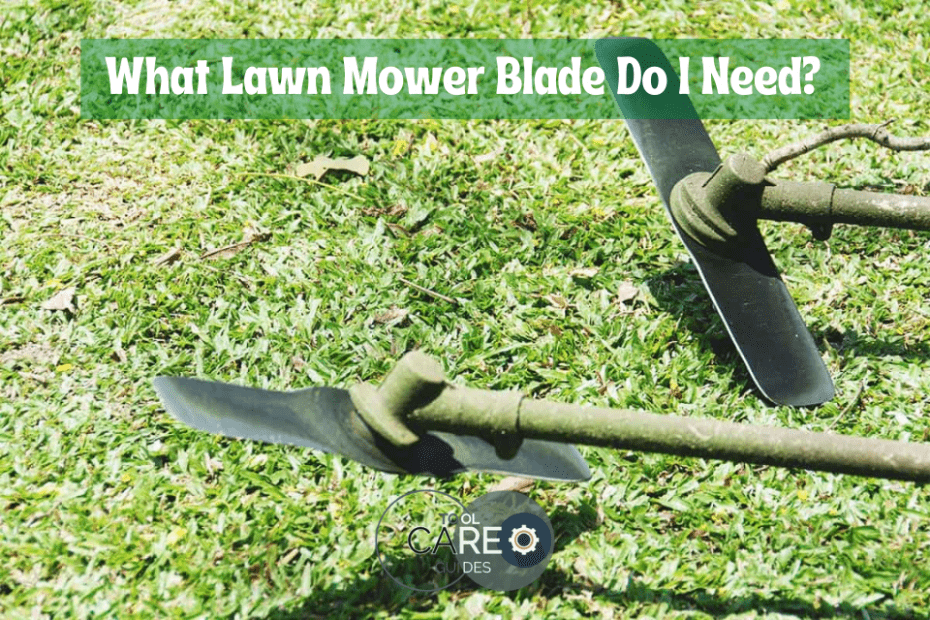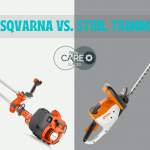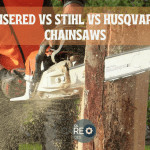Quick Overview of This Article
Who doesn’t love a well-maintained and mowed lawn? Well, we all want a yard with short grass and clean cuts. Besides investing in a lawnmower, you need suitable blades to achieve clean cuts and a lush yard. The blade you have installed in your mower is a significant determinant of the cut quality the mower will achieve. Therefore, you must understand the different blades you can use and their working functionality.
Mostly, mowers are limited to only using blades that match their configurations and measurements. However, you can still choose other options to achieve different goals with your lawnmower. The different type of mowers has varying designs, which provide a variety of mulching and lifting options.
You’ve probably heard people saying they have different blade types and how they used to achieve clean cuts. And maybe you are wondering, “What lawnmower blade do I need?” The type of lawnmower blade you require depends on various factors. These factors include the type of cut you want to achieve, the grass conditions, and the season.
More so, the capabilities, type, and model of your lawnmower play a significant role in the kind of blade you will need. So, let’s take a look at the various lawnmower blades, their features, and how to determine the blade you need.
The Three Kinds of Lawn Mower Blades
Typically, there are three types of lawnmower blades. However, the terminologies may vary depending on the region. Here are the three kinds of lawnmower blades:
- High-Lift Blades
High-lift blades can also be referred to as a 2-in-1, regular, or basic blade. These blades are ideal for mowers that are equipped with baggers. Manufacturers make high-lift blades with an aerodynamic design that cut grass and propel the clippings up then out of the discharge chute.
Most riding lawn mowers are equipped with high-lift blades but are designed with more enormous wind wings to promote higher airflow to lift the clippings up and out of the large discharge chute.
- Low-Lift Blades
If your lawn has dry and short grass, the low-lift blade is the best choice for you. More so, they are ideal if you are mowing in a sandy area. Low-lift blades do not create a high airflow as that produced by high-lift blades. Therefore, they have less suction, making the mower produce lesser debris and airborne dust.
- Mulching Blade
Mulching blades are commonly referred to as 3-in-1 blades. They are the best choice if you mow your lawn without a bagger. The design of a mulching blade enables it to pick up the grass clippings that have been cut and re-cuts them into tiny clippings. Environmental experts recommend using mulching blades since the little grass clippings do not litter and can be left all over the lawn to decompose.
Once they decompose, they release nutrients to the soil, making the grass grow healthy and green to make your lawn beautiful and lush. Mulching blades are the most flexible blades since they can be used with or without a bagger. However, using the bagger is ineffective since it cannot firmly push the grass clippings out of the discharge chute as high-lift blades.
It would be best if you also considered the following factors when you use mulching blades:
- If the grass you want to mow is too long, i.e., longer than four inches, the blades will be less effective at re-cutting the clippings into smaller pieces.
- Ensure that you always a sharp mulching blades since dull mulching blades do not cut and re-cut the grass effectively, which may lead to your lawn having left-over grass clumps.
What Type of Lawnmower Blade Do You Need?
Lawnmowers have been in use since 1830 when Edwin Beard Budding, an England engineer, invented the first lawnmower. Ever since, inventors have upgraded mowers into electric and even robotic models. More so, people have optimized the lawn cutting process to yield the best results.
Over the years, inventors have come up with different lawnmower blades that can be used in various lawnmower models. Some blades have enhanced performance and efficiency when you throw a particular task at them. In the following section, we shall bring to your limelight various lawnmower blades you can use depending on your likes, preferences, and goals. These lawnmower blades include:
- Standard (Deck) Blade
The standard blade is the most common blade installed in a new lawnmower. Though they are fitted in new mowers, they are not the best viable option while mowing. Deck blades are straight and do not offer mulching features or good lifting. Therefore, if you have tall grass on your lawn, standard blades are not the best option. They are ideal for mowing lawns that are already well-maintained.
Standard blades are mostly fitted in lawnmowers that discharge grass clippings sideways. The blades are slightly bent at the ends, creating some suction to pull the grass up and enable the blades to cut the grass precisely. However, you should note that they only create minimal suction since the tilt at the edge is not huge.
Before selecting a standard blade, you should consider a few factors, including the land you plan to mow. Most lawnmower users prefer standard blades since they are highly effective whether mowing in damp or dry areas. However, it would be best to use them in lawns with thick grass patches because the blades can precisely cut them and push them to the bagger. The only downside is that they might leave the property looking uneven since they may not remove the tiny grass clumps from the yard.
Furthermore, standard decks do not provide enough suction to push the grass clippings through the discharge chute. Therefore, the grass clippings may clutter up and block the discharge chute, preventing the debris from reaching the bagger. This may prevent your lawnmower from running efficiently or leave your lawn with trash.
- Lifting Blades
Lifting blades are designed with a lift/ slight curve behind the cutting edge to create air pressure and suction that pushes grass clippings through the discharge chute. This lifting design makes these blades very ideal for side discharging or bagging. However, lifting blades do not have features that encourage mulching.
The lifting blades vary depending on how low or high the curve is:
- Low-lifting blades: These blades are the most ideal when cutting grass in dusty or sandy areas since their low suction prevents debris and dust from spreading,
- Medium lifting blades: They can cut grass in a slightly damp area but are most suitable for regularly and well-maintained yards.
- High/ Extremely high blades: These blades possess side discharge capabilities and are the best choice when mowing a lawn with tall and thick grass. However, they are not ideal for use in sandy or dusty areas.
You should also note that the lift that lifting blades produce strains the engine. Therefore, you should have a powerful machine if you want to use the high-lifting blades since the higher the lift, the higher the need for power.
- Notched (Rolled) Blades
Rolled blades are similar to lifting blades since they also have curved edges. The major difference between notched and lifting blades is that notched blades’ curve has notch. This notch makes the blade produce stronger airflow, which pushes the grass clippings through the discharge chute at a higher speed.
With this capability, rolled blades are suitable when mowing tall or moist grass and using a bagger.
- Mulching Blades
It is straightforward to distinguish a mulching blade from other lawnmower blades since they are curved and have longer cutting edges. These blades are ideal for mulching grass by cutting them into tiny grass clippings then releasing them on the lawn. However, mulching blades are not suitable for side discharge and air suction.
Mulching or 3-in-1 blades are designed with curvier edges that cut and recuts the grass into fine pieces before releasing them on the lawn. Though they produce less suction, mulching blades can still trim and straighten the grass. However, you should not use the blades to cut tall or dense grass due to the low suction power, leading to grass clippings clogging the deck.
- Toothed (Gator) Blades
Gator blades are uniquely-built to provide both lifting and mulching capabilities. If you’ve been looking for a blade that will promote effective bagging, mulching, and side discharging, a toothed blade is your best shot.
You can quickly identify them since they usually have three curved teeth positioned behind their cutting edges. The function of these teeth is to increase the suction and lifting power, enhance the discharging ability, and produce highly tiny grass clippings.
The teeth of the gator blade have a specific angle that functions as a secondary blade to pull the grass upwards and cut it precisely. As the mower keeps moving, this particular angle continues to push the grass to the cutting edges to ensure that the grass clippings are cut repeatedly. With this design, gator blades can also cut tall grasses into tiny clippings.
For the best results, you can fit a mulching kit to the gator blade to promote the uniform distribution of the grass clippings back to the ground. The fine grass will act as a mulch and improve your soil’s nutrient level to encourage the growth of fruits and flowers in the yard. Alternatively, you can equip your mower with a grass collector bag to store all the grass clippings. Doing this will leave the yard looking good, and you won’t need to clean it.
What Size Lawn mower Blade Do You Need?
You are probably aware that lawnmowers usually have different sizes. When it comes to blades, the same scenario applies since blades are in various sizes, such as 21-inches and 42-inches blades. However, lawnmower blade sizes are interesting since they are not different as you may think.
If you take a 21-inch blade and compare it to a 42-inch blade, you will realize that their difference is just a few inches. If that’s the case, how can you find the right size for your needs? And how do you categorize the lawnmower blades by size?
Well, it is simple. Your lawnmower’s deck side is what determines the blade size you will require. That’s why the 42-inch blade won’t be 21 inches longer than a 21-inch blade. You do not require a longer blade since each blade is designed for a specific lawnmower. If your lawnmower is a 42-inches model, you will need a 42-inch blade, and the 21-inches lawnmower will require a 21-inch blade.
How to Find the Right Size of Lawnmower Blade
To ensure that you get the right size of lawnmower blade that you need, you have to measure various aspects of the blade. The correct measurements will ensure that you get the right lawnmower blade for your mower.
These aspects include:
- Length of the blade: Measure it diagonally from one cutting tip to the other.
- Center hole: You need to determine the type of the center hole and also the diameter
- Outer holes: Measure the distance from the center of one center hole to the other, as well as the diameters
- Width of the blade: Measure it at the blade’s center
- Thickness of the blade: This is also measured at the blade’s center
Does the Size of the Blade Matter?
To answer your question, the size of the blade matters. When purchasing a new blade, one of the critical aspects to consider is the blade’s size. Furthermore, the length of the blade must be compatible with the size of your lawnmower’s deck and will also affect the size of the cuts.
The size of the blade also significantly impacts the mowing time. If you need to mow a vast area, you should use a bigger and more powerful lawnmower. If you have installed large-sized blades in the powerful lawnmower, the mowing time will be reduced significantly. Thus, mowing larger areas with lesser time.
Can You Use a Bigger Blade?
Before I answer your question on whether you can use a bigger blade or not, there is something I would like you to understand. Your lawnmower deck is designed to be compatible with a specific size of a lawnmower blade. Mostly, the blade leaves a leeway of about a half-inch from the deck, which is not an ample space.
So, what if you install a bigger blade? You should not run your lawnmower with a blade longer than the one your manufacturer recommends. Reasons? First, you will be forcing it to fit, and it can’t due to the incompatible deck size. Secondly, you may damage the blade, or the blade may damage the lawnmower’s deck or engine. Lastly, it can pose a very severe health hazard.
Can You Use a Smaller Blade?
Now that you’ve learned that you should not use a bigger blade, you are probably wondering, “Can I use a smaller blade with my lawnmower?” Practically, you can. If the mounting fits, you can install a smaller blade on your lawnmower. if the mounting fits However, is it advisable to use a smaller blade?
It is not a good idea to use a smaller lawnmower blade than the manufacturer recommends since it can damage the blade or the lawnmower. Also, it can injure you or the one using the lawnmower.
A lawnmower is designed to work with a specific size of the blade. Therefore, installing a smaller blade can lead to severe problems. If you use a smaller blade in a powerful lawnmower, the engine will continue producing high power output, making the blades spin at extremely high RPMs. The speed can cause unsafe vibration levels, posing a severe health hazard.
Can you Use Lawnmower Blades from Different Manufacturers?
Over the years, manufacturers have standardized lawnmower blades, and therefore most if not all can be interchanged regardless of the manufacturer. However, you should take the proper precautions when using different blades.
You must ensure that the blade fits perfectly with your lawnmower, even if you have borrowed it from a different mower or bought it from a dealer. Ensure that the length of the blade, width and thickness, size and spacing of the outer holes, and the center holes align completely. If they all match with your lawnmower, you have the greenlight. However, if some features are not compatible, it is unwise to mount the blade on your mower.
What’s the Difference Between the Aftermarket and Original Blades?
If you own a lawnmower, you have probably wondered whether to buy Original Equipment Manufacturer (OEM) blades or to go with aftermarket replacement blades. OEM blades are specifically designed to fit on specific lawnmowers. Therefore, they fit perfectly with their target models and are similar to those provided on your lawnmower when you bought it.
Usually, OEM replacement blades and parts are well built and very high quality. Generally, purchasing original equipment or replacement parts is better and more secure than buying them from an untrustworthy dealer or company. However, that’s not 100% true since aftermarket blades are not automatically worse.
Though aftermarket blades are not as high-quality and trustworthy as original equipment, they are also not bad. When it comes to aftermarket blades, the first factor that determines if they are worth investing in is the type of blade. It is essential to note that some aftermarket blades are of the same quality as OEM blades since they are produced by the same companies that make the original blades. However, the branding may be different.
Aftermarket blades are also relatively cheap compared to original blades. Though you may tempt to go with the aftermarket blades due to their inexpensive cost, some may be of low-quality standards. Some companies sell blades that failed the quality check as aftermarket blades. These blades are usually poorly designed and may end up not fitting your lawnmower.
If your mower is still under warranty, you should avoid voiding the warranty with aftermarket blades. Some manufacturers may declare your warranty null and void if you alter the mower or replace the original blades with aftermarket blades. To avoid such inconveniences, always contact your mower’s manufacturer before making significant adjustments on your lawnmower.
With the above information in mind, you should make proper decisions about purchasing replacement blades or parts for your lawnmower. It is not necessary that you purchase OEM lawnmower blades. You can decide to replace your lawnmower blades with aftermarket blades as long as you do the required due diligence.
Frequently Asked Questions (FAQs)
- After how long should I replace the lawnmower blade?
Typically, lawnmower blades can last for about 100 to 200 hours. However, this is dependent on the mowing intensity and how frequently you are using the lawnmower. For instance, if you mow vast areas, your blades will not last long. Further, if the mower blades hit a tree, a rock, or a hard object while cutting, you might have to change it. Generally, it would be best to replace the lawnmower blades once per year.
- When should I sharpen my lawnmower blades?
How frequently you sharpen your blades will be determined by factors such as the soil conditions, type and length of the grass you’re mowing, and how often you’re using the lawnmower. The most straightforward way to determine when to sharpen the blades is to check the cut’s quality. If the cuts appear like the blade is tearing the grass rather than cutting it precisely, it is time to sharpen the blades.
- What material is used to make lawnmower blades?
Manufacturers usually use alloy steel or high carbon to make lawnmower blades. This material is rugged and super resistant to breakage.
Final Verdict
I do not doubt that you now know the different lawnmower blades available in the marketplace. With this knowledge, you can now select the lawnmower blade that perfectly aligns with your likes, preferences, and needs.
Once you have purchased the blades (preferably OEM blades), ensure that you fit them properly and take care of them for maximum durability. Clean your lawnmower, check your blades, regularly sharpen them and replace them if need be.




